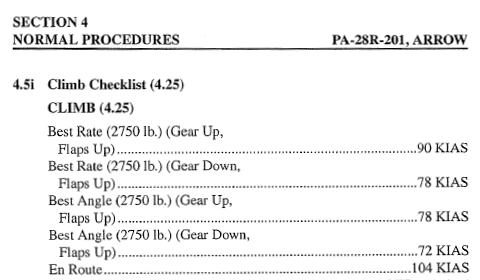Comanche gear travel time is about 3 seconds. I’ve been taught the same “no runway left for landing” but I stick to my own. When I have 3 seconds to glide I raise the gear. It just flies so much better
There’s a saying, “when the engine stops, the aircraft belongs to the insurance company”. Personally I’d rather have the best rate of climb, and take the risk of a gear-up landing if the engine stops during the short interval I might be able to get it safely back on the runway. I’ve never really understood the conventional wisdom.
I don’t think you can teach for .every circumstance. But yes if its.a long runway you might well lrave.the gear down in case of.engine failure.but the counter to this is you might not climb very quickly and if you have hills or obstacles ahead you might think it better to get the wheels up as soon as possible and gain some altitude. This is all thought out in the TEM and then.you brief the take off. There is no strict method its the PICs decision.
The SOP I learned when flying RU during my CB-IR was:
• positive rate
and
• no more possibility to land on the runway
The home base for that Piper Arrow is a 2.8km runway, you can get an EFATO at 400ft and still land on your wheels on asphalt. But if the gear had been up, you wouldn’t have time to extend it again, then it’s a belly land on the single runway.
One limitation to this was when departing from Leipzig and its 3.6km runway, where it was ok to retract even though there was like half the runway left, but at a 1000ft AGL we’d have time to extend the gear again.
gallois wrote:
With some aircraft you will struggle to get 90kts in the climb with gear down.
Second that. My Comanche struggles to reach 100 knots with gear down in level flight. On 90 knots it still climbs but only barely. 65 to 70 knots is good with gear down. Aerodynamics is interesting due to the open wheel wells. Same with the Arrow.
If I recorded correctly there have been first retractables just before WW2 where too high of a speed with gear down led to a stall due to wheel wells being too close at the front of the wing. Don’t remember the type, but I’ve seen it in a museum. German aircraft.
With some aircraft you will struggle to get 90kts in the climb with gear down.
You might only get 250fpm. This is especially so with some light twins OEI.
So best climb angle or rate will still be based on speed but that ROC would be a lot lower.
lionel wrote:
Yes, but climbing at 90kt gear up better than climbing at 78kt gear up better than climbing at 78kt gear down.
Can you just try climbing at 90kn gear downand note the climb rate, to see if it produces a better climb rate than at 78kn ?
Thank you Lionel, it makes sense now. I’ll go find the table and check if it affects IAS.
Capitaine wrote:
Why is the best rate of climb speed slower with the gear extended?
More parasitic drag (air friction) with gear extended compared to gear up, so in the balance of things higher speeds are more “punitive” with gear down, so the point where the balance between excess lift (climbing force / induced drag) and parasitic drag is the best will be at lower speed.
This may also be an effect that gear down affects the general airflow, and so affects the IAS/CAS difference? Can you check the table that makes the relationship between IAS and CAS?
Capitaine wrote:
climbing at 78kt gear up ‘should’ be better than 78kt gear down
Yes, but climbing at 90kt gear up better than climbing at 78kt gear up better than climbing at 78kt gear down.
In the PA28 POH, VY clean is 90 KIAS and VY gear extended is 78 KIAS. Why is the best rate of climb speed slower with the gear extended? It feels counter-intuitive: climbing at 78kt gear up ‘should’ be better than 78kt gear down. VX is the same, but less pronounced: 78 and 72 KIAS. I’ve put some thought into it and can’t work it out. What am I missing?
